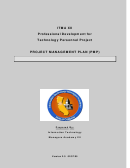Project Management Plans
ADVERTISEMENT
PROJECT MANAGEMENT PLANS
Project Management Plans
Overview
Project Management Plan Suggested Outline Subjects
Crosswalk between the Suggested PMP Outline Subjects and a Listing of Project Planning Elements
Elements of Deactivation Project Planning
Examples From Project Management Plans
Overview
The purpose here is to assist project managers and project planners in creating a project plan by providing
examples and pointing to information that have been successfully used by others in the past.
Section 4.2 of DOE Guide 430.1-3,
DEACTIVATION IMPLEMENTATION GUIDE
discusses the content and
purpose of deactivation project management plans. It is presented as a suggested outline followed by other
potential subjects. For the convenience of readers, that information is repeated below.
The examples address each of the subject areas in the guide. They have been collected by first reviewing a large
number of existing plans from several sites. This review resulted in a list of 40 project management plan elements
that appeared in one plan or another. Typical examples of those 40 elements are correlated to the Guide’s
suggested outline. To find an example for a specific subject:
1.
Go to the
Crosswalk Table
that correlates the suggested outline subjects with a listing of Project
Planning Elements.
2.
For the subject of interest, select an element in the first column of the Elements Table where there is an X
to indicate relevance.
3.
In the last column of the
Elements
Table, select a link to examples.
Planners are advised not to go to extremes in adapting this material . Use what is useful for your project (that is, a
graded approach). A project management plan necessarily addresses the core of a project consisting of specifying
the work, coordinating and progressing schedules and budgets, and delivery of the final result. Other subjects
should be addressed only to the extent they are specifically important to the project, or otherwise important to the
customer who is paying for the work.
Where generic or site-wide policies, standard requirements, and/or standard practices are required to be
addressed, many of which may be embedded in customary site or national processes, maximum adoption by
reference to existing directives, programs, and manuals is encouraged. (For example, there is no need to
specifically address radiological controls unless there is some unusual aspect of the project that falls outside the
radiological controls manual or that presents a special hazard. Every radiological worker on the project should
already be trained to standard radiological practices.)
Project Management Plan Suggested Outline Subjects
Discussion from the DOE Guide 430.1-3, DEACTIVATION IMPLEMENTATION GUIDE is repeated here for
convenience of the reader.
The project plan consists of two distinct but interrelated parts: (1) the project plan document and (2) the
supporting appendices. The project plan document provides the strategies and methods for managing the project.
ADVERTISEMENT
0 votes
Related Articles
Related forms
Related Categories
Parent category: Business
 1
1 2
2 3
3 4
4








